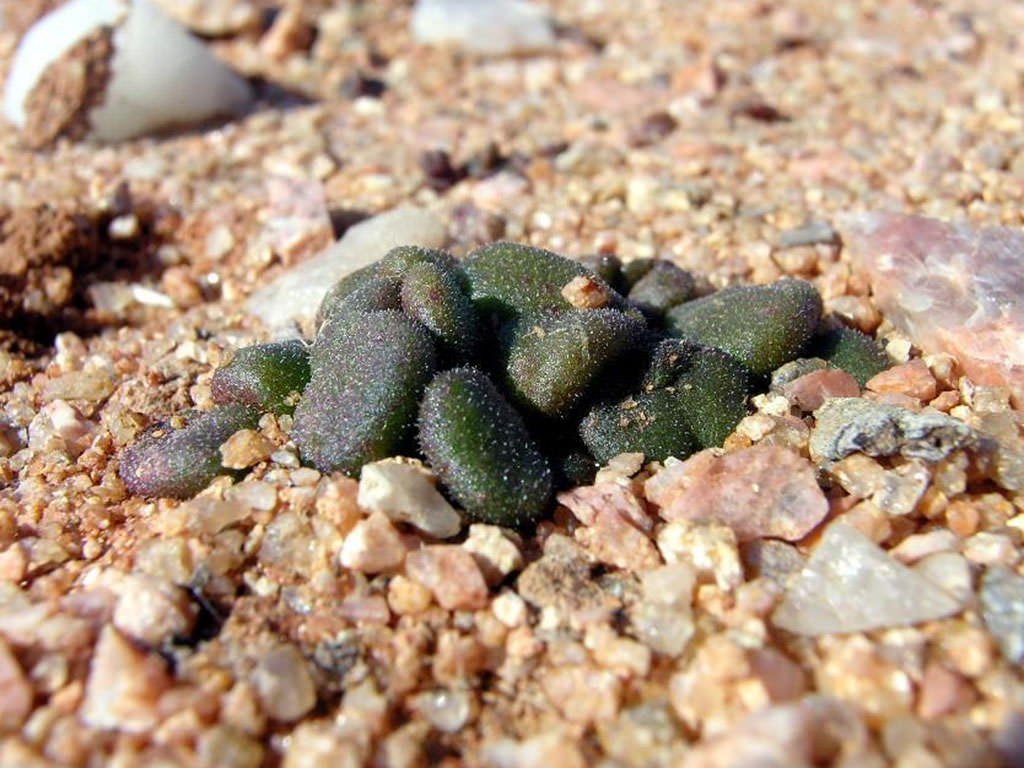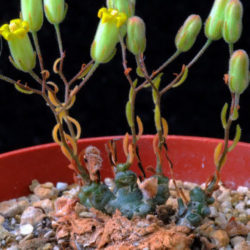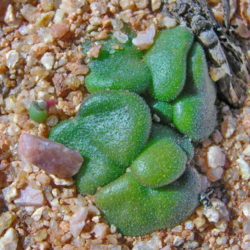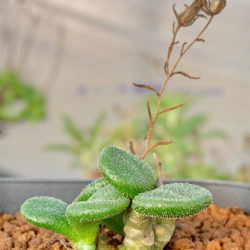Scientific Name
Tylecodon pusillus Bruyns
Scientific Classification
Family: Crassulaceae
Genus: Tylecodon
Origin
This species is native to South Africa. It occurs in pockets in quartzitic sandstones from Jakkalswater to the south of Steinkopf in the Northern Cape.
Description
Tylecodon pusillus is a dwarf branched succulent with a tuberous base, short branches, and green leaves with translucent trichomes. It grows up to 1.8 inches (4.5 cm) tall. The tuberous base is up to 1 inch (2.5 cm) in diameter, underground or partly exposed, and with grey peeling bark. Branches are up to 0.8 inches (2 cm) in diameter. The leaf-bearing branches are up to 1.2 inches (0.3 cm) in diameter. Leaves are appressed to the ground and crowded at the branch tips. They are kidney- to heart-shaped, with upper surface flat to channeled, lower surface convex, up to 0.5 inches (1.3 cm) long, and up to 0.7 inches (1.8 cm) wide. Flowers are upright, cylindrical, pale yellow, and appear in up to 2.8 inches (7 cm) tall thyrses from mid-summer to fall.
Etymology
The specific epithet "pusillus (pus-ILL-us)" is a Latin adjective meaning "very little, very small" or "insignificant" and refers to the small size of the plant.

How to Grow and Care for Tylecodon pusillus
Light: This succulent can survive direct sunlight exposure without problems, but it will grow beautifully in partial shade.
Soil: A well-draining soil mix is a key to healthy T. pusillus. Poor drainage and overwatering most commonly cause root rot in both indoor and outdoor plants. Indoors, it is essential to use pots with at least one drainage hole at the bottom.
Hardiness: Like all Tylecodons, this succulent is highly tolerant when it comes to high temperatures and also tolerant of cold, frost-free conditions during the winter. T. pusillus can withstand temperatures as low as 30 to 50 °F (-1.1 to 10 °C), USDA hardiness zones 10a to 11b.
Watering: As a winter grower, T. pusillus requires careful watering during winter and spring. Get the soil wet, and then wait until it is dry before watering again. In summer, reduce watering to once per month.
Fertilizing: Use liquid fertilizer for cacti and other succulents during winter.
Repotting: You do not need to repot this plant often. You can do it when you see that the container becomes too small or shallow.
Propagation: T. pusillus can be grown either by seed or by cuttings. Sow the seeds in fall and winter. The best time for taking cuttings is the fall.
Learn more at How to Grow and Care for Tylecodon.
Toxicity of Tylecodon pusillus
T. pusillus is adapted to avoid animal predation being poisonous. Therefore, keep it away from children, pets, and livestock.
Links
- Back to genus Tylecodon
- Succupedia: Browse succulents by Scientific Name, Common Name, Genus, Family, USDA Hardiness Zone, Origin, or cacti by Genus
Photo Gallery
Click on a photo to see a larger version.


